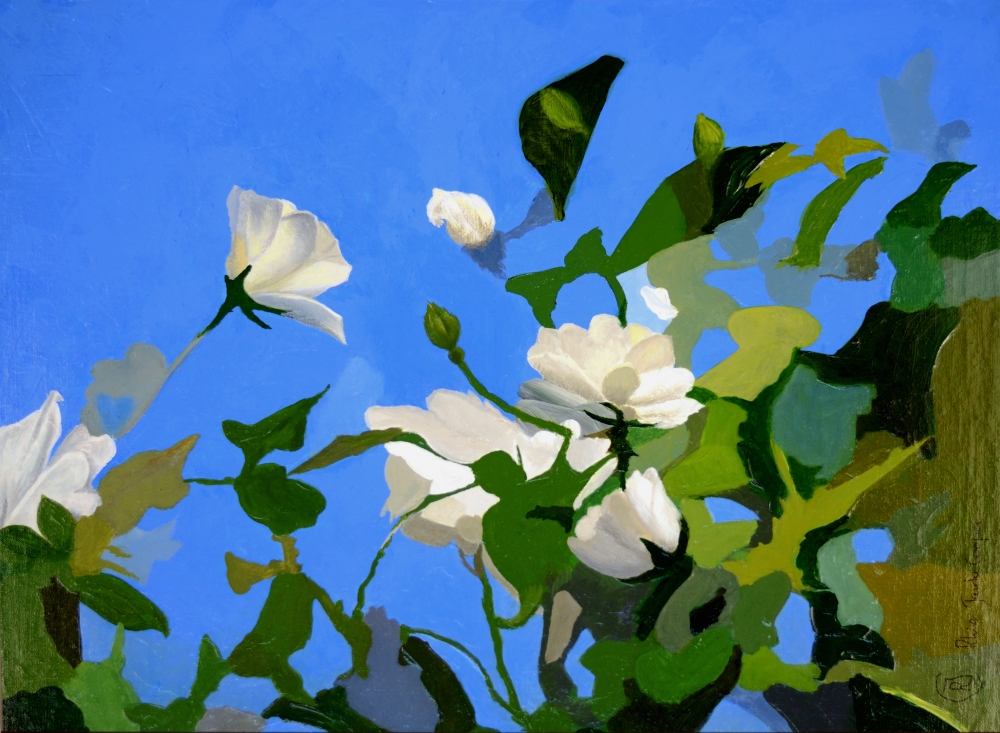The beauty of imperfection: Understanding the Wabi-Sabi concept in art
In a world that often glorifies perfection and flawlessness, the Japanese philosophy of Wabi-Sabi offers a refreshing perspective that celebrates the beauty of imperfection, impermanence, and incompleteness. Rooted in Zen Buddhism and traditional Japanese aesthetics, Wabi-Sabi encourages us to find beauty in the simplicity, asymmetry, and natural decay of things. But what exactly is Wabi-Sabi, and how does it manifest in the realm of art?
 White Roses of York, original abstract painting. Rhia Janta-Cooper
White Roses of York, original abstract painting. Rhia Janta-Cooper
What is Wabi-Sabi:
The term "Wabi-Sabi" derives from two separate Japanese concepts: "wabi" and "sabi." "Wabi" originally referred to the loneliness and poverty of living in nature, while "sabi" connoted the beauty or serenity that comes with age and wear. Over time, these concepts merged to form Wabi-Sabi, which encapsulates a more profound aesthetic philosophy centered on the acceptance of transience and imperfection.
Applying Wabi-Sabi to art:
In art, Wabi-Sabi finds expression through various mediums, techniques, and interpretations. Here are some key ways in which the Wabi-Sabi concept manifests in artistic endeavors:
-
Aesthetic simplicity: Wabi-Sabi values simplicity over extravagance. In painting, this might mean using minimal brush strokes to evoke emotions or leaving empty spaces to invite contemplation. In pottery, it might involve creating unadorned, earthy vessels that bear the marks of the artist's hands.
-
Embracing imperfection: Rather than seeking flawless precision, Wabi-Sabi art embraces imperfections as inherent aspects of beauty. For example, a crack in a ceramic bowl or a weathered piece of wood becomes a testament to the passage of time and the natural cycle of decay and renewal.
-
Natural materials and processes: Wabi-Sabi artists often favor natural materials like wood, stone, or clay, as well as techniques that highlight their inherent qualities. They may deliberately incorporate elements of randomness or unpredictability, such as allowing glazes to run freely or embracing the irregularities of handcrafted objects.
-
Appreciation of transience: Central to Wabi-Sabi is the recognition of the fleeting nature of existence. Artworks may capture moments of ephemeral beauty or depict subjects in various stages of growth, decay, or transformation, reminding viewers of the impermanent nature of all things.
-
Harmony with nature: Wabi-Sabi art often reflects a deep reverence for nature and its seasonal rhythms. Paintings may depict landscapes in different seasons, while sculptures might mimic the organic forms found in the natural world. Through art, practitioners seek to evoke a sense of harmony and interconnectedness with the environment.
Examples of Wabi-Sabi art:
-
Japanese tea ceremony utensils: Tea bowls, bamboo ladles, and other utensils used in the Japanese tea ceremony embody the Wabi-Sabi aesthetic with their rustic simplicity and subtle imperfections.
-
Ink wash paintings: Traditional ink wash paintings, such as those by masters like Sesshū Tōyō, often employ minimalistic compositions and brushwork to convey a sense of tranquility and impermanence.
-
Rustic pottery: Wabi-Sabi pottery, exemplified by the work of potters like Shoji Hamada, celebrates the raw beauty of unglazed surfaces, irregular shapes, and spontaneous kiln effects.
-
Ikebana (Japanese flower arranging): Ikebana arrangements emphasize asymmetry, simplicity, and the use of natural materials, reflecting the Wabi-Sabi principles of appreciating beauty in the transient and imperfect.
Conclusion:
In a world that often prioritizes perfection and uniformity, the Wabi-Sabi concept offers a profound alternative-one that invites us to embrace the beauty of imperfection, impermanence, and incompleteness. Through its application in art, Wabi-Sabi encourages us to cultivate a deeper appreciation for the natural world, find beauty in simplicity, and savor the fleeting moments that make life rich and meaningful. As we immerse ourselves in the Wabi-Sabi aesthetic, we may discover a profound sense of peace, harmony, and connection with the world around us.
 White Roses of York, original abstract painting. Rhia Janta-Cooper
White Roses of York, original abstract painting. Rhia Janta-Cooper